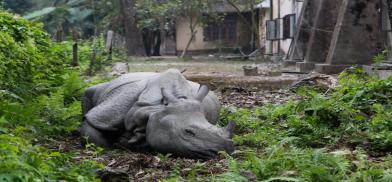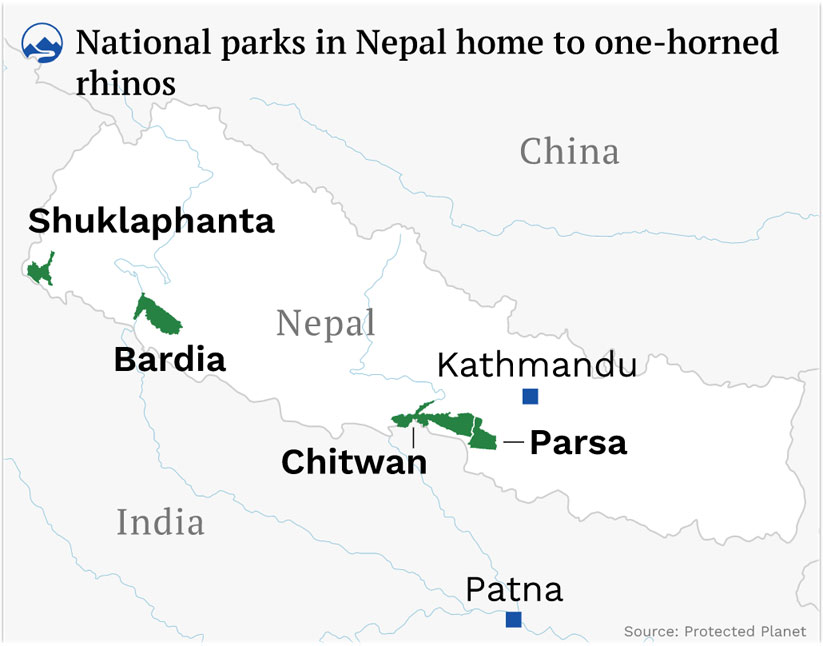As Nepal’s rhino population increases, protecting rhino habitat becomes a challenge
In February 2023, Chitwan National Park hosted the 3rd Asian Rhino Range Countries, which saw the adoption of the Chitwan Declaration for Asian Rhino Conservation, 2023 by delegations from Bhutan, India, Indonesia, Malaysia and Nepal.

On 20 January 2023, two rhinos were found dead near the bank of the Narayani River in Nepal’s Chitwan National Park. According to postmortems conducted by park officials, the 14-year-old female rhino and 4-year-old male calf had been killed by electrocution. The horn of the female rhino was missing.
Ganesh Prasad Tiwari, a spokesperson for Chitwan National Park, says the case is being treated as poaching and is under investigation. He tells The Third Pole that poachers may have fixed a wire across the rhinos’ regular movement routes, hooked up to the power supply from a nearby temple.
The pair were among a total of 14 rhinos that have been found dead in Chitwan National Park and its surrounding buffer zones since the start of the 2022-23 fiscal year (July 2022 to July 2023), according to data provided to The Third Pole by Nepal’s Department of National Parks and Wildlife Conservation (DNPWC). Although this total is lower than in previous years, the last decade overall has seen an upward trend in the number rhinos dying in Chitwan.
Experts say in many cases, human activity may be to blame, from the impacts of infrastructure projects, invasive species, and perhaps most worrying, a resurgence of poaching.

Rhino poaching
According to Nepal’s latest rhino census, the country’s population of one-horned rhinos – a globally vulnerable species that survives only in the floodplains of lowland Nepal and northeast India – has been steadily on the rise for the past two decades. The 2021 census put the national population at 752, compared to 409 in 2005. Over 90% live in Chitwan National Park, with smaller populations in Bardia, Shuklaphanta and Parsa National Parks.
Chitwan’s rhino population has had a chequered history. Deforestation and poaching caused the population to fall from thousands to around 100 in the late 1960s. The population rebounded after the establishment of the national park and successful conservation efforts, but fell once again in the early 2000s during a wave of poaching coinciding with a period of armed conflict and political instability in Nepal. 94 rhinos were poached in Chitwan National Park between 2000 and 2004.
Since 2006, conservation initiatives have seen Chitwan’s rhino population gradually increase once again. In a remarkable conservation success, only one rhino was killed by poachers between 2014 and 2019, in April 2017.
But poaching resurfaced in 2020, coinciding with the Covid-19 pandemic. Four rhinos were poached in 2020 and two more in 2021 – in each case, the horn was removed. “During the lockdown, people returned home from cities and were jobless, so poachers may have used locals to kill rhinos and paid them,” says Ganesh Pant, an ecologist at the DNPWC.
In the fiscal year 2021-22, Nepal’s National Park Authority filed three cases against individuals suspected to be involved in rhino poaching in Chitwan, and 13 people were arrested in rhino-related cases, Ganesh Prasad Tiwari tells The Third Pole.
Despite an international ban on trade in rhino horn, there is still substantial demand in China and Vietnam, where it is used in traditional medicine and as a status symbol.
Invasive species
Aside from poaching, human activity may be indirectly responsible for many more rhino deaths in Nepal. In the fiscal year 2021-22, 10 rhinos died after becoming stuck in mud in swampy areas of Chitwan National Park. Detailed data collated by the DNPWC and shared with The Third Pole reveals a consistent rise in the number of rhino deaths due to drowning or getting stuck in swamps between 2017-18 and 2021-22.
According to Pant, this increase may be due to the spread of non-native plant species which, after being introduced by humans, have now covered many ditches and swampy areas inside the park. “[While] grazing, the rhinos get entangled with invasive species and sometimes fall into the swampy areas and get stuck there,” Pant explains.
The American creeper species Mikania micrantha has been identified as a serious threat to the rhino habitat in Chitwan National Park, and the 2021 rhino census found that 35% of rhino habitat in the park had been invaded by the species. Babu Ram Lamichhane, chief of the National Trust for Nature Conservation-Biodiversity Conservation Centre says that the spread of other invasive plant species in Chitwan’s grassland habitats such as Parthenium hysterophorus, Lantana camara, Chormolaena odorata are posing new threats to the habitat of rhinos and other grassland-dependent species, and that precautionary measures are needed to limit their spread.
Construction impacts
In July 2022, Nepal’s Ministry of Forests and Environment formed a five-member committee to investigate the increase in rhino deaths in Chitwan National Park. According to the committee’s report – which was submitted to the government on 18 September 2022 but was not made public – the deaths of six rhinos in the last five years were linked to construction activities inside and near Chitwan National Park.
The latest incident took place on 25 January 2022, when an 11-year-old male rhino died after falling into a roadside ditch. This had been dug to expand a road near Chitwan National Park, in the Bharatpur metropolitan area. The government of Nepal issued a directive in April 2022 on building infrastructure in a wildlife-friendly way, but critics say this is yet to be properly implemented in practice.
Maheshwar Dhakal, director general of the DNPWC, tells The Third Pole: “We have just brought this policy in, and it might take some time to fully implement it, but we are very serious [about it] and have been monitoring [its implementation].”
The July 2022 committee report also suggests that construction upstream on the rivers that flow into Chitwan National Park – the Narayani, Rapti and Reu – may have resulted in changes to their flow, with consequences for the park’s rhinos. The report says that embankments constructed for irrigation on the Rapti River have narrowed its natural flow, causing a decrease in the extent of flood plains that provide habitat for the rhinos. Sand is also extracted at several locations on the rivers upstream of Chitwan. “Those activities have limited the movement of rhinos and confined them in a small area leading to higher density that has resulted into increased fighting among males,” the report says.
According to the DNPWC investigation report, 36 rhinos have died in Chitwan in fights with other rhinos since July 2017. According to rhino expert Shanta Raj Gyawali, not all the recent rhino deaths in Chitwan are cause for alarm. “We have a good population of rhinos in Chitwan National Park, so there is no need to worry much about natural deaths. It would have been of bigger concern if deaths were due to diseases.” He says that deaths caused by ditches, falls and getting stuck in the mud are normal given the size of Chitwan’s rhino population. However, Gyawali emphasises that caution is needed. He says man-made threats are a persistent threat to rhino conservation, and that while currently at low levels, they can escalate at any point in the absence of strong security.
Failure to act
The July 2022 committee was the third established by the Nepal government to look into the causes of rhino deaths in Chitwan. But according to Maheshwar Dhakal, current director general of the DNPWC, many of the resulting recommendations have not been put into action.
For instance, the committee formed in early 2020 had suggested keeping two elephants at security posts for use in anti-poaching patrolling, but the next committee, formed in October 2020, found that this was not implemented. This second committee also highlighted a failure by the national park authority to undertake management of grassland habitat twice a year to ensure it remains suitable for rhinos, so they don’t need to go outside the park to find food, putting them at risk of electrocution or poaching.
The March 2020 committee also offered recommendations on regular patrolling, removal of invasive plant species, implementation of a joint operation cell, improvement of grassland habitat and swampy areas, coordination between park officials and farmers to reduce pesticide use, and translocation of rhinos. But the July 2020 committee highlighted the failure to enact these recommendations.
Maheshwar Dhakal says this is down to a lack of resources to implement recommendations. Due to a lack of budget, he says, the DNPWC has also been unable to implement ID-based rhino monitoring or establish a forensic laboratory. He also points to a lack of a yearly plan from park officials as a reason why recommendations of the investigation committees have not been actioned.
In February 2023, Chitwan National Park hosted the 3rd Asian Rhino Range Countries, which saw the adoption of the Chitwan Declaration for Asian Rhino Conservation, 2023 by delegations from Bhutan, India, Indonesia, Malaysia and Nepal. Among a suite of actions the countries committed to, many could help to reduce threats to Chitwan’s rhinos, including strengthening patrolling, improving habitat management, tackling invasive species, and “adopting wildlife-friendly measures in developmental projects to minimize adverse effect on rhino habitat”. (Courtesy The Third Pole)
I wanted to thank you for your time due to this fantastic read!!
I definitely loved every bit of it and i also have you saved as a favorite to check
out new stuff on your web site.








Post a Comment